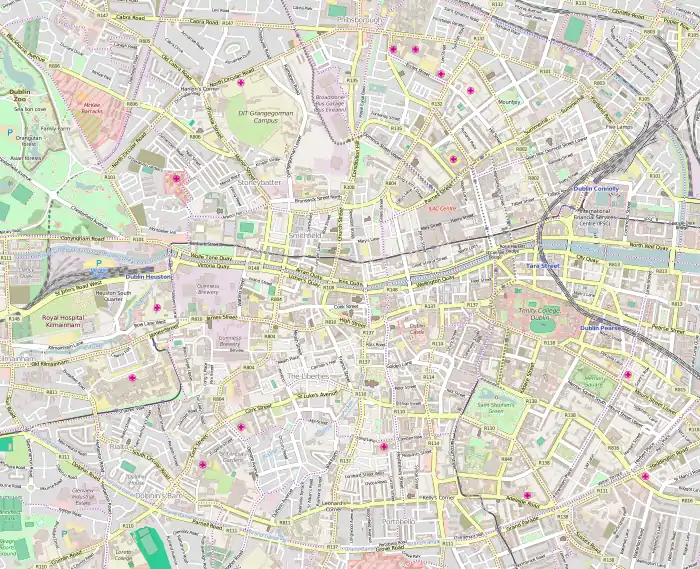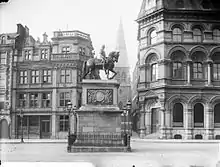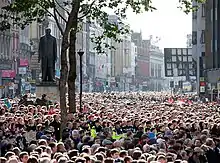College Green, Dublin
College Green (Irish: Faiche an Choláiste) is a three-sided plaza in the centre of Dublin, Ireland. On its northern side is the Bank of Ireland building, which until 1800 was Ireland's Parliament House. To its east stands Trinity College Dublin. To its south stands a series of 19th-century buildings that are mostly banks.
 | |
 | |
| Native name | Faiche an Choláiste (Irish) |
|---|---|
| Namesake | Trinity College, Dublin |
| Length | 260 m (850 ft) |
| Width | 38 metres (125 ft) |
| Location | Dublin, Ireland |
| Postal code | D02 |
| Coordinates | 53°20′40″N 6°15′36″W |
| west end | Dame Street |
| east end | Trinity College, Westmoreland Street, College Street |
| Other | |
| Known for | Trinity College, restaurants, nightclubs, statues, |
.jpg.webp)
Streets leading onto College Green are Dame Street to the west, Grafton Street to the south, and Westmoreland Street to the north. College Green has been used as an assembly point for major political rallies. In the mid-1990s, United States President Bill Clinton addressed a crowd during his visit to Ireland. President Barack Obama spoke at the site in a major address during his visit in May 2011.[1]
History and layout

The area was once known as Hoggen Green from the Old Norse word haugr meaning mound, or barrow. The cemetery at College Green consisted of several burial mounds, which are thought to have contained the remains of some of the Norse kings of Dublin.[2] Between Church Lane and Suffolk Street the Norse had their Thing, an assembly and meeting-place, which was still to be seen in the 17th century. All along College Green, called Hoggen Green by the English, lay their barrows.[3] Hoggen gave its name to the convent of St Mary de Hogges, which stood roughly where the Bank of Ireland is now and was a major landowner in the area until the Reformation. Originally laid out as a triangular green, it now a rough trapezoid. The site has been historically used in celebration, with newly appointed Viceroys of Ireland being welcomed on the street.[4]
Several public monuments stand in College Green, including a 19th-century statue of Henry Grattan, one of the leading members of the old Irish Parliament, which stands facing Trinity College. Another statue, standing further back, is of Thomas Davis and a memorial fountain both in leaden bronze. Previously this was the site a statue of King William III of England on horseback, by Grinling Gibbons, which features in James Joyce's story The Dead.[5] Erected in 1701, the statue was attacked and defaced numerous times through the 18th, 19th and 20th centuries, leading to many repairs.[6] It was eventually taken down after 277 years when it was badly damaged in an explosion on 11 November 1928, Armistice Day,[7] with the head having been stolen in 1929. The area was the temporary site of an air raid shelter during World War II. The fountain, by Edward Delaney, features four figures with trumpets which represent the four provinces of Ireland.[5]
Daly's Club, originally frequented by members of the old Irish Parliament, moved to number 3, College Green, in 1791 and remained there until it closed in the 1820s.[8]
Architecture
The Ulster Bank headquarters on College Green was built in the late 1970s. Despite objections from groups like the Dublin Civic Group, a collection of mostly Victorian buildings which faced onto College Green, Suffolk Street and Church Lane were demolished in 1976 to make way for the new development. The high-domed Victorian façade on College Green was kept, but the interior was entirely remodelled.[9]
Number 6-8 was formerly the site of the Jury's Hotel. The Victorian was sold when Jury's relocated to Ballsbridge. The contents were auctioned, with the ornate mahogany bar sold to a buyer in Zurich. The site was bought by Patrick Gallagher in July 1979, who demolished the hotel in 1980 and built a granite-clad office block designed by Burke-Kennedy Doyle and Partners in its place.[10]
Traffic restriction

Since July 2009, College Green, during peak times on working days, has been accessible only to pedestrians, buses, taxis and cyclists.[11]
In 2016, plans were published for College Green to be fully pedestrianised, apart from a public-transport lane along the Trinity College side, to create a large public space in front of the Bank of Ireland. However, in October 2018 An Bord Pleanála, the state planning agency rejected the plan.[12][13]
Proposed developments
There is ongoing debate about the future of College Green, with plans being led by the Green Party-led Dublin City Council to pedestrianise the plaza being piloted during 2019,[14][15] after planning permission for a permanently pedestrianised plaza was rejected by An Bord Pleanála in 2018.[16]
See also
References
Notes
- Henry McDonald (23 May 2011). "Barack Obama cuts short Ireland visit after concerns over volcanic ash cloud". The Guardian. Retrieved 23 May 2011.
- Hoggen Green ("Vikings in Dublin or Dyflin as they called it". Robert O'Connor. Viking Network)
- Scandinavian Relations With Ireland During the Viking Period (A. Walsh, author. Dublin: The Talbot Press Limited. 1922)
- Casey 2005, p. 377.
- Doherty, Neal. The complete guide to the statues and sculptures of Dublin City. Dublin. pp. 73–74. ISBN 978-1-909895-72-0. OCLC 907195579.
- "Statue of King William III". Dublin City Council. 2019-05-02. Retrieved 2021-01-27.
- "Equestrian statue of King William III, outside the Bank of Ireland, Dublin". The William Henry Fox Talbot Catalogue Raisonné. Retrieved 2021-01-27.
- T. H. S. Escott, Club Makers and Club Members (1913), pp. 329–333
- McDonald 1985, p. 118.
- McDonald 1985, p. 265.
- "Change to College Green traffic restrictions". 18 November 2009. Retrieved 20 December 2016.
- "College Green pedestrianisation plans to go before An Bord Pleanála". 4 October 2016. Retrieved 20 December 2016.
- Olivia Kelly (18 October 2018). "College Green plaza plans are 'dead', council chief claims". Irish Times. Retrieved 18 October 2018.
- "College Green traffic ban for three summer Sundays to test plaza plan". The Irish Times. June 23, 2019.
- Lynott, Laura. "New trial to ban traffic on College Green for three days". Irish Independent.
- Kilraine, John (17 October 2018). "Pedestrian plaza plans for Dublin's College Green refused". RTÉ.
Sources
- Casey, Christine (2005). Dublin: The City Within the Grand and Royal Canals and the Circular Road with the Phoenix Park. Yale University Press. ISBN 978-0-30010-923-8.CS1 maint: ref=harv (link)
- McDonald, Frank (1985). The Destruction of Dublin. Gill and MacMillan. ISBN 0-7171-1386-8.CS1 maint: ref=harv (link)
| Wikimedia Commons has media related to College Green, Dublin. |